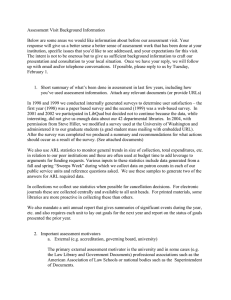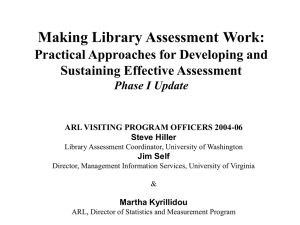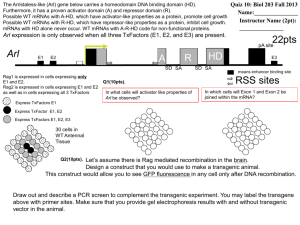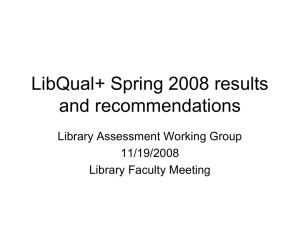RC-7 Airborne Reconnaissance Low (ARL)
advertisement
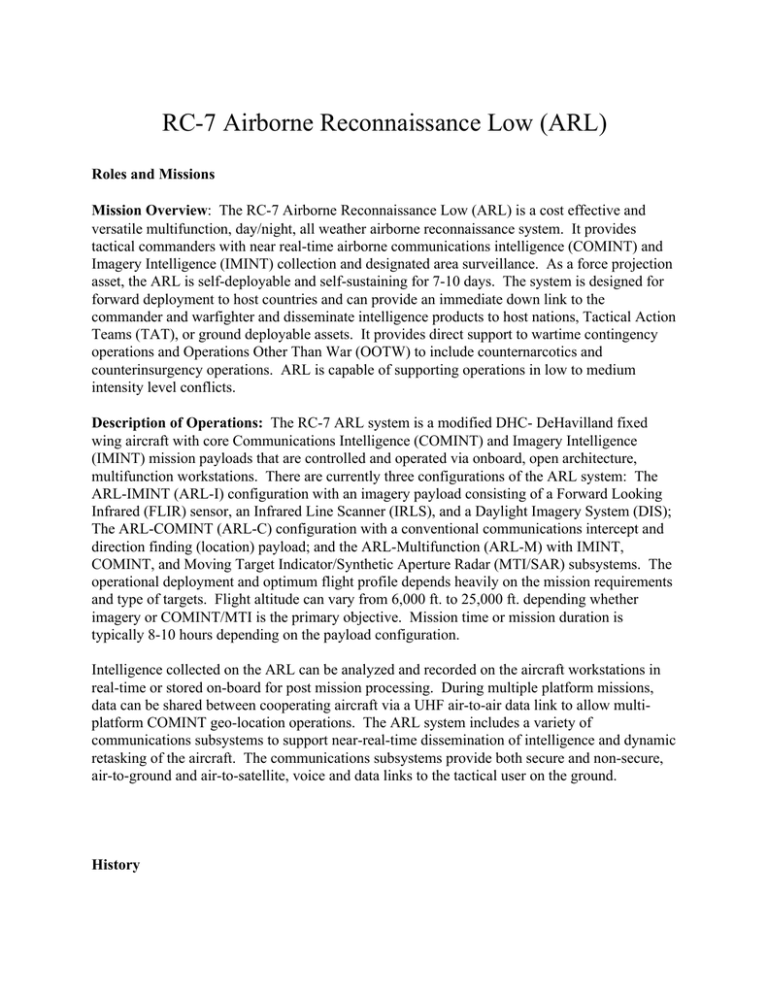
RC-7 Airborne Reconnaissance Low (ARL) Roles and Missions Mission Overview: The RC-7 Airborne Reconnaissance Low (ARL) is a cost effective and versatile multifunction, day/night, all weather airborne reconnaissance system. It provides tactical commanders with near real-time airborne communications intelligence (COMINT) and Imagery Intelligence (IMINT) collection and designated area surveillance. As a force projection asset, the ARL is self-deployable and self-sustaining for 7-10 days. The system is designed for forward deployment to host countries and can provide an immediate down link to the commander and warfighter and disseminate intelligence products to host nations, Tactical Action Teams (TAT), or ground deployable assets. It provides direct support to wartime contingency operations and Operations Other Than War (OOTW) to include counternarcotics and counterinsurgency operations. ARL is capable of supporting operations in low to medium intensity level conflicts. Description of Operations: The RC-7 ARL system is a modified DHC- DeHavilland fixed wing aircraft with core Communications Intelligence (COMINT) and Imagery Intelligence (IMINT) mission payloads that are controlled and operated via onboard, open architecture, multifunction workstations. There are currently three configurations of the ARL system: The ARL-IMINT (ARL-I) configuration with an imagery payload consisting of a Forward Looking Infrared (FLIR) sensor, an Infrared Line Scanner (IRLS), and a Daylight Imagery System (DIS); The ARL-COMINT (ARL-C) configuration with a conventional communications intercept and direction finding (location) payload; and the ARL-Multifunction (ARL-M) with IMINT, COMINT, and Moving Target Indicator/Synthetic Aperture Radar (MTI/SAR) subsystems. The operational deployment and optimum flight profile depends heavily on the mission requirements and type of targets. Flight altitude can vary from 6,000 ft. to 25,000 ft. depending whether imagery or COMINT/MTI is the primary objective. Mission time or mission duration is typically 8-10 hours depending on the payload configuration. Intelligence collected on the ARL can be analyzed and recorded on the aircraft workstations in real-time or stored on-board for post mission processing. During multiple platform missions, data can be shared between cooperating aircraft via a UHF air-to-air data link to allow multiplatform COMINT geo-location operations. The ARL system includes a variety of communications subsystems to support near-real-time dissemination of intelligence and dynamic retasking of the aircraft. The communications subsystems provide both secure and non-secure, air-to-ground and air-to-satellite, voice and data links to the tactical user on the ground. History Platform: The DHC-7 was developed by DeHavilland of Canada to meet a world wide market for short to middle range Short Take Off and Landing (STOL) transports. The DHC-7 was chosen by the Army as the platform for ARL because of its ability to carry the necessary sensors, endurance, STOL performance, and multi-engine configuration. In March 1991, the Army awarded a contract for one airborne imagery system (ARL-I) with options for five additional multifunction systems to California Microwave, Inc. (CMI), of Belcamp, Maryland. In April 1991 the Army awarded a sole source contract to ESL of Sunnyvale, California for two airborne COMINT systems (ARL). These three interim capability systems were fielded within two years of contract award to USSOUTHCOM. The Army subsequently exercised its contract option with CMI and procured three multifunction ARL-M aircraft. The Army modified the contract in December 1995 to add an MTI/SAR capability to the three ARL-M aircraft in production. California Microwave Inc. sub-contracted with Hughes Aircraft, Los Angeles, California, for three nondevelopmental item (NDI) Hughes Integrated SAR (HISAR) radars. Two of the multifunction systems with MTI/SAR capability were delivered and fielded to USFK in September 1996. The third ARL-M was delivered in September 1997. In December 1996 the Army exercised its contract option again and procured two additional ARL-M aircraft with delivery scheduled in December 1998. Sensors: The ARL program was created in November 1990. The Appropriations Act for Fiscal Year 1990 directed that the former GRISLY HUNTER program (now ARL-I) and the Airborne Radio Direction Finding (ARDF) program (now ARL-C) be combined into a single multifunction mission aircraft program. Both GRISLY HUNTER and ARDF programs were in response to urgent requirements expressed by SOUTHCOM for support of counter-narcotics; and low intensity conflict operations. In November 1995, in response to a Commander, USFK and PACOM requirement, the Army directed that an MTI/SAR capability be added to the ARL-M so that it could replace the OV-1D Mohawk aircraft that were to be retired in Korea. The MTI/SAR subsystem was successfully procured, integrated, and fielded in two ARL-Ms in less than ten months. Basic Specifications Platform: The RC-7 airframe is a dual pilot aircraft modified to operate for extended 8-10 hour Missions. It is an all metal, high wing monoplane powered by four Pratt and Whitney PT6A-50 turboprop engines driving composite construction, four bladed, constant speed, variable and reversible pitch propellers. At ranges to 1400 nm., cruise speed is 220 knots and it can loiter at speed as low as 110 knots. The DHC-7 is capable of taking off loaded under high/hot conditions from an unimproved runway and climbing to a maximum of 20,400 feet MSL (without supplemental oxygen for crew) and 25,000 feet MSL (with crew on supplemental oxygen). The RC-7 is equipped with Aircraft Survivability Equipment (ASE) suitable for countering threats expected in its theater of operations. Figure 1 ARL-C Configuration Figure 2 ARL-I Configuration Figure 3 ARL-M Configuration Sensors: ARL is a multi-INT, (combined COMINT and IMINT) reconnaissance system. The COMINT subsystem on the ARL-M, called Superhawk, provides an Electronic Support Measures (ESN) capability for intercept, identification, and location of both conventional and Low Probability of Intercept (LPI) communication signals in the HF, VHF, UHF, and SHF frequency bands. The ARL-C configuration uses the AN/ASQ-216 COMINT subsystem to provide an intercept and direction finding capability against conventional communication emitters in the HF, VHF, UHF, and SHF frequency bands. The IMINT subsystem on both the ARL-I and ARL-M include an Infrared Line Scanner (IRLS), Forward Looking Infrared (FLIR) sensor, and a Daylight Imaging System (DIS). The ARL-M also integrates an MTI/SAR capability which provides the detection and tracking of moving targets (MTI) at long stand off ranges as well as "medium” image resolution synthetic images of fixed targets. The MTI radar is multi-mode, performing wide area MTI, single beam scan and narrow sector search for improved tracking and probability of detection. The CAI-8601 AMIDARS Infrared Line Scanner (IRLS) is designed for day/night airborne applications which require search and surveillance of large ground areas. The IRLS is employed as an area search sensor as well as a compliment to the FLIR and DIS. The system is a three axis stabilized sensor with a continuously variable cross track field of view of up to 120o. The IRLS has two display modes, the waterfall mode and the roam mode. Because the IRLS is an area search sensor it does not provide narrow field of view images of the target. It must be used in conjunction with the other imagery sensors to obtain more detailed target information. The WF-360TL Forward Looking Infrared (FLIR) system is a stabilized, electro-optical FLIR video camera designed to operate in the far-IR (8 - 12 micron) spectrum, detecting long-wave heat radiated directly from the target to the sensor, such as hot exhaust from equipment, persons, or animals in a background of wood or bush. The FLIR camera is mounted in a 2 axis stabilized gimbal, housed in an elevator which retracts the sensor into the aircraft to allow the sensor to be protected and hidden when in use. The system has a wide (11.1o x 14.8o - 2.7X magnification) o o o FOV and a narrow (2.7 x 3.6 - 1 1X magnification) FOV and provides 360 coverage under the aircraft. The FLIR signal is fed directly into on-board operator workstations for real-time processing. Additionally, the signal is recorded on Hi-8mm video tapes for post-mission processing and historical archiving. This signal data may be annotated via real-time video or freeze frame RF links to remote processing facilities. The Daylight Imaging Systems (DIS) is a charge coupled device (CCD) camera contained within a stabilized WESCAM gimbal. The WESCAM gimbal is housed in an elevator which retracts the sensor into the aircraft to allow it to be protected and hidden when not in use. The high resolution camera has a finite conjugate lens with an effective variable focal length from 16.5mm to 396mm. A remotely controlled extender and doubler provides 4X zoom capability (66min 1584 mm focal length). The DIS provides 360o coverage under the aircraft and is most effective in sunlight or intense artificial light to resolve fine details not visible to the FLIL The DIS signal is fed directly into on-board operator workstations for real-time processing. Additionally, the signal is recorded on Hi-8mm video tapes for post-mission processing and historical archiving. This signal data may be annotated via real-time video or freeze frame RF links to remote processing facilities. The Hughes integrated Synthetic Aperture Radar (HISAR) is a multi-mode system which provides for the detection of moving targets (MTI) at long stand-off ranges, and collection of operationally effective SAR images of near photographic quality. The radar provides three MTI modes of operation (Wide Area, Narrow Sector Search, and Single Beam Scan) and two SAR modes of operation. The diagram below depicts the various modes of operation. Fugure 4 MTI/SAR Modes The SUPERHAWK Electronic Support Measues (ESM) subsystem, installed in the ARL-M uses a modified version of the TACJAM-A and selected commercial off the shelf equipment including intercept and DF antennae, receivers, signal processing equipment and control and display equipment. The system is an all-digital, highly modular, highly automated set of equipment that is designed to operate for signal acquisition and direction finding. SUPERHAWK will enable the detection, analysis, and geo-location (multiple platform) of conventional and low probability of intercept (LPI) signals. The signals may be voice, data, or PROFORMA. The system has the ability to stare at an instantaneous bandwidth (IBW) and can scan across radio frequency bandwidths. SUPERHAWK can operate/DF in a single platform or multiplatform configuration. Data is shared between aircraft via a narrowband RF data link. The SUPERHAWK subsystem is designed to use multiple software loads, enabling the ARL-M platforms to support SOUTHCOM mission needs. Data Links/ Communications: The ARL communications systems were designed to provide the onboard mission analysts with the means to communicate with the tactical user on the ground as well as with other aircraft. A variety of radios provide this functionality in the HF, VHF, UHBF and L-band frequency bands. These include: the ARC-210, which provides air-to-ground UHF LOS voice/data communications; the LST-5C, which provides UHF SATCOM/LOS voice/data communications; the ARC-190 for HF voice; the ARC-164 for air-to-air data networking; and the BMS L-Band transceiver for freeze frame and five video transmission. Ground/Surface Systems: Although a separate ground or surface system is not part of the ARL system, the ARL is capable of down-linking to a variety of existing ground stations and portable ground terminals. The ARL-M can currently down-link its MTI data to the Joint STARS Medium Ground Station Module (MGSM). The same capability is planned in the follow on Joint STARS Common Ground Station (CGS). In addition, the ARL-M was provided an "interim” ground portable processing capability for MTI/SAR data called the Remote Graphical Display System (RGDS). The RDGS allows near real-time display of MTI/SAR data on a Sun base Sparc20 workstation. This processing/display capability was included with two the ARL-M fielded to Korea in September 1996. The ARL-M and ARL-I configurations also provide compatible down-links to a number of standard portable processing ground stations for live video and freeze frame imagery display. These include the TACLINK II imagery receiver, the portable Secondary Exploitation Workstation (SEWS), the Portable Remote Receive Station (PRRS), and the LSSC-200 and ACT-106 man portable imagery stations. Systems Development and Acquisition Programmed Capabilities: The ARL fleet is currently programmed to be upgraded with Joint Tactical Terminals (JTT) beginning in FY1999. Addition of the JTT will enhance ARL reporting and improve interoperability with other DOD platforms by allowing the ARL to transmit and receive intelligence information via the TRIXS and TIBS networks. Efforts began in FY1997 to adopt and integrate the Joint Signals Intelligence (SIGINT) Avionics Family (JSAF) Low Band Subsystem (LBSS) being developed by the Joint Airborne SIGINT Program Office (JASPO) into the ARL-M. This upgrade will provide a multi-thread, reconfigurable, wide band intercept and direction finding capability against next generation digital communications systems. Integration of the first development unit (DU) will start in lQFY00. Six ARL-M systems are planned to receive LBSS upgrades. Initiatives: With DARO support, the Army is investigating the incorporation of a wide band microwave Common Data Link (CDL) into the ARL to provide both a high capacity line-ofsight (LOS) and direct air to satellite data link to remote ground processing sites. This capability would provide significant operational payoff in ARL’s ability to perform split-based operations, interoperate with other CDL users such as Guardrail/Common Sensor and USAF Special platforms, and provide higher capacity real-time down-link for all ARL mission data. An initial demonstration of a CDL equipped ARL was conducted in July 1, 1997 at Hunter Army Airfield, Savannah, Georgia. The ARL system was developed to accommodate open architecture, modular/reconfigurable mission specific sensor payloads. The Army continues to investigate state-of-the-art NDI technology such as lowlight level TV (LLTV), 2nd generation FLIR, multi-spectral sensors, foliage penetrating radar and MTI/SAR radar enhancements, to identify potential new and improved sensors for ARL that will support warfighter needs. Program Points of Contact: Product Manager, Aerial Common Sensor SFAE-IEW&S-SG Ft Monmouth, NJ 07703 (732) 427-5211, DSN – 987-5211
